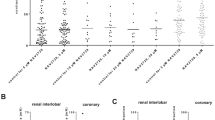Summary
-
1.
Renal arteries from rabbits were chemically skinned by incubation with Triton X-100, and subsequently stored in buffered glycerol.
-
2.
In the presence of Mg-ATP, of EGTA-buffered calcium, and of calmodulin, miniature strips of the skinned arteries developed tension the strength of which was approx. 15–20% of that of viable renal arteries.
-
3.
Tension development was dependent on the concentration of both calcium and calmodulin.
-
4.
The effect of eight vasodilator drugs, the majority of them being “calmodulin antagonists” or “calcium antagonists”, on the skinned arteries was assessed. In concentrations up to 10−3 M, verapamil, D-600, and hydralazine proved to be ineffective, and the same was found with the dihydropyridine derivatives, nifedipine and felodipine, at 0.6×10−3 M and 0.8×10−4 M, respectively, i.e. at saturation in a 9∶1 contracting buffer/ethanol mixture (v/v).
-
5.
In a concentration-dependent manner, trifluoperazine, W-7, and fendiline relaxed Ca-calmodulin-induced tension or prevented tension development when given prior to the activation by Ca-calmodulin. However, considerably higher concentrations of the drugs were necessary for half-maximal relaxation than the reported concentrations for half-maximal saturation of hydrophobic binding sites at the calmodulin molecule.
-
6.
These findings suggest that at therapeutic blood levels, the vasodilator properties of calcium antagonists and other direct vasodilators cannot be explained by interference with the binding of myosin light chain kinase to calmodulin.
Similar content being viewed by others
References
Adelstein RS, Eisenberg E (1980) Regulation and kinetics of the actin myosin interaction. Ann Rev Biochem 49:921–956
Boström SL, Ljung B, Mardh S, Forsen S, Thulin E (1981) Interaction of the antihypertensive drug felodipine with calmodulin. Nature 292:777–778
Crouch Th, Holroyde MJ, Collins JH, Solaro RJ, Potter JD (1981) Interaction of calmodulin with skeletal muscle myosin light chain kinase. Biochemistry 20:6318–6325
DiSalvo J, Gruenstein E, Silver P (1978) Calcium dependent phosphorylation of bovine aortic actomyosin. Proc Soc Biol Med 158:410–414
Hofmann F, Wolf H (1981) Basic properties of myosin light chain kinase from bovine cardiac muscle. Cold Spring Harbour Conferences on Cell Proliferation, vol. 8. Protein phosphorylation, pp 841–847
Johnson JD, Vaghy PL, Crouch TH, Potter JD, Schwartz A (1982) An hypothesis for the mechanism of action of some of the Ca2+ antagonist drugs: calmodulin as a receptor. Advances in pharmacology and therapeutics II. Proceedings of the 8th Int. Congress of Pharmacology, Tokyo 1981. vol 3:121–138
Khayyal M, Gross F, Kreye VAW (1981) Studies on the direct vasodilator effect of hydralazine in the isolated rabbit renal artery. J Pharmacol Exp Ther 216:390–394
La Porte DC, Wiermann BM, Storm DR (1980) Calcium-induced exposure of a hydrophobic surface on calmodulin. Biochemistry 19:3814–3819
Metzger H, Stern HO, Pfitzer G Rüegg JC (1982) Calcium antagonists affect calmodulin-dependent contractility of a skinned smooth muscle. Drug Res 32:1425–1427
Mrwa U, Troschka M, Gross C, Katzinski L (1980) Calcium sensitivity of pig carotid actomyosin ATPase in relation to phosphorylation of the regulatory light chain. Eur J Biochem 103:415–419
Sparrow MP, Mrwa U, Hofmann F, Rüegg JC (1981) Calmodulin is essential for smooth muscle contraction. FEBS Letters 125:141–145
Spedding M (1982) Comparison of “Ca2+-antagonists” and trifluoperazine in skinned smooth muscle fibres. Br J Pharmacol 75:25P
Tanaka T, Hidaka H (1980) Hydrophobic regions function in calmodulin-enzyme(s) interactions. J Biol Chem 255:11078–11080
Wolf H, Hofmann F (1980) Purification of myosin light chain kinase from cardiac muscle. Proc Natl Acad Sci USA 77:5852–5855
Author information
Authors and Affiliations
Additional information
Supported by Deutsche Forschungsgemeinschaft within SFB 90, “Cardiovasculäres System”
Rights and permissions
About this article
Cite this article
Kreye, V.A.W., Rüegg, J.C. & Hofmann, F. Effect of calcium-antagonist and calmodulin-antagonist drugs on calmodulin-dependent contractions of chemically skinned vascular smooth muscle from rabbit renal arteries. Naunyn-Schmiedeberg's Arch. Pharmacol. 323, 85–89 (1983). https://doi.org/10.1007/BF00634253
Received:
Accepted:
Issue Date:
DOI: https://doi.org/10.1007/BF00634253



